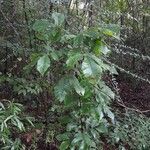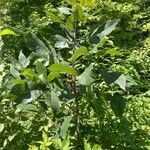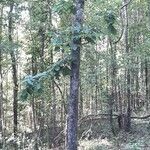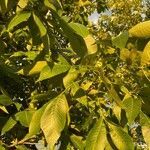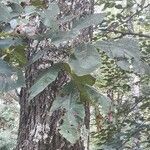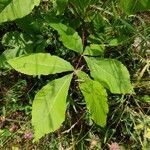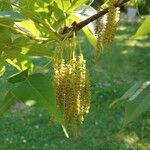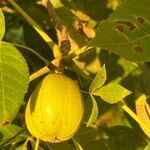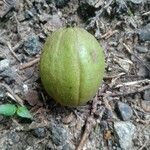Trees , to 30 m. Bark light gray, smooth or fissured or exfoliating with small platelike scales or narrow strips. Twigs reddish brown, slender, essentially glabrous or sparsely scaly. Terminal buds reddish brown to tan, ovoid, 5-15 mm; outer scales sparsely scaly, hirsute to glabrous, inner scales finely pubescent, sparsely scaly, bud scales imbricate; axillary buds protected by bracteoles fused into hood. Leaves 2-6 dm; petiole 3-14 cm, glabrous to moderately pubescent near rachis, moderately scaly, rachis glabrous or finely puberulent. Leaflets (3-)5-7(-9), lateral petiolules 0-2 mm, terminal petiolules 2-18 mm; blades ovate to elliptic or obovate, not falcate 4-21 × 2-10 cm, margins finely to coarsely serrate, apex acuminate to narrowly acuminate; surfaces abaxially glabrous to densely pubescent with unicellular and 2-4-rayed fasciculate hairs, large peltate scales and small irregular, round, and 4-lobed peltate scales in spring, usually becoming glabrous in fall, adaxially scaly in spring. Staminate catkins pedunculate, to 13 cm, stalks glabrous or densely pubescent, bracts hirsute at tips; anthers hirsute. Fruits tan to reddish brown, obovoid, spheric or ellipsoid, not compressed to compressed, not angled, 2-4.5 × 2-3.5 cm; husks rough, 2-5 mm thick, partially dehiscent or dehiscing to base, sutures smooth or slightly winged; nuts tan, obovoid to ellipsoid, not compressed to compressed, not angled, rugulose; shells thick. Seeds sweet.
More
Bark light or dark gray, on younger trunks tight and patterned, becoming finely furrowed and checked, later rough and deeply furrowed; outer bud-scales sparsely resinous-dotted, otherwise glabrous; petiole, rachis, and lower lf-surface soon glabrous, or pubescent only on the larger veins and in the vein-axils; lfls usually 5(7), the terminal one broadly oblanceolate to obovate; fr subglobose to obovoid, 2–3.5(–5) cm; husk 2–6 mm thick, eventually dehiscent to the middle, sometimes only along one or two sutures; nut 2–3 cm, rather thin-shelled, pale buff, slightly 4-angled or smooth, round or compressed; kernel astringent, scarcely edible, varying to bland; 2n=64. Upland woods; s. Vt. and se. N.H. to Mich., se. Io., and e. Kans., s. to Fla. and e. Tex.
A tree that loses its leaves. It grows 24-30 m high. The trunk is 30-60 cm across. The bark is grey and has narrow ridges. It has an irregular spreading crown. The leaves are mid green. They are 15-25 cm long. There are 5-7 leaflets which are sword shaped. These are 7.5-15 cm long. The flowers are very small and greenish. The male flowers are in slender drooping catkins. There are 3 hanging from one stalk. There are 2-10 female flowers at the tip of the same twig. The fruit are 2.5-5 cm long and slightly pear shaped. The nuts are small. It produces large numbers of nuts. They are thinned shelled and egg shaped. They can be bitter or sweet.
